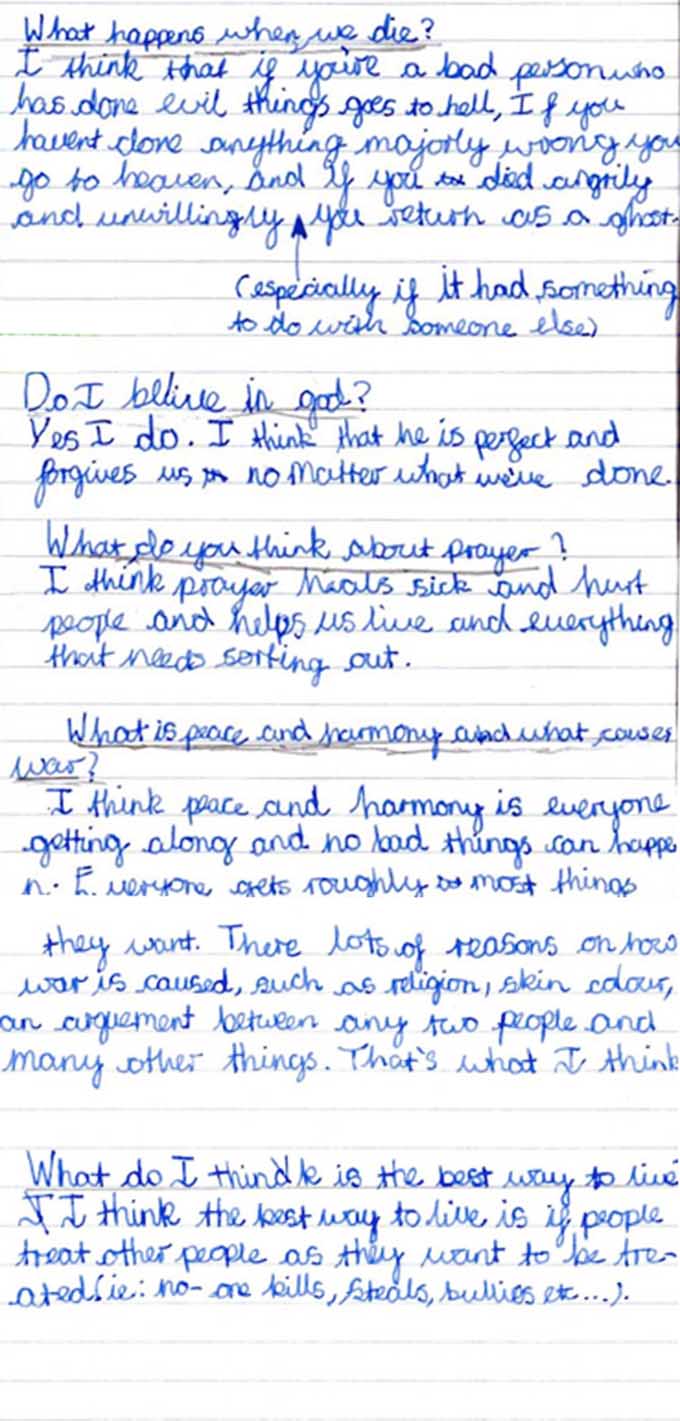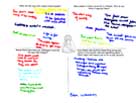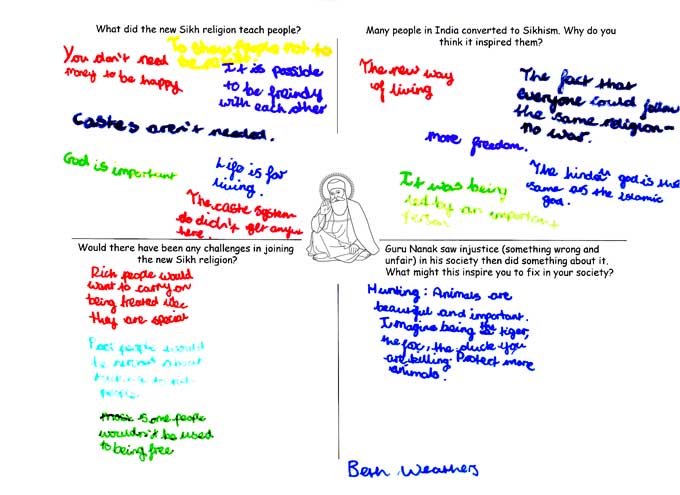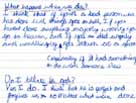Exemplification for foundation subjects
Religious education exemplification standards file level 3
Pupil's profile
Pupil A is a keen and creative student. She likes thinking for herself but sometimes finds religious ideas and concepts confusing. She achieves most when she can link her experiences with her ideas.
Evidence groups
What makes a harmonious community? Focus on the Kartarpur community
Context
This work was planned for the start of key stage 3 and aimed to introduce pupils to a religion with a local presence - Sikhism. This was the first time many pupils had encountered Sikhism, even though two nearby towns have large Sikh communities.
Following the local Agreed Syllabus and using the theme of expressions of spirituality, pupils learnt about religious community and the early community of Sikhs at Kartarpur. In pairs, they reflected on this ideal example of community before individually selecting the features they thought were most important to Guru Nanak. Finally, to bring together everything pupils had learnt about Sikh teaching, belonging and values, pupils imagined a community rule board for the Kartarpur Community.
Pupil's work
_medium_tcm8-17410.jpg)
Key features of the Kartarpur community
Pupil A thought five features made the Kartarpur community special.
_medium_tcm8-17411.jpg)
Features of an equal community
Pupil A thought of the question 'What might Indian people want from a new religion?' on her own.
Rules for the Kartarpur Community of Guru Nanak
Pupil A's work gives an indication of her own values and her description of Sikh values.
Next steps
To progress, Pupil A needs to:
collect her ideas together in a clear and coherent way
show that she understands some links between the Kartarpur community and her own community
clarify which values from the Sikh community she does and does not accept, for example by considering what she would and would not like if she lived in Kartarpur for a week.
What happened at the first Vaisakhi?
Context
This piece of work aimed to help pupils reflect on the religious idea of sacrifice. They learnt about the founding of the Sikh Khalsa and the story of the five loyal Sikhs ('Panj Pyara') who were willing to sacrifice their lives for their faith. They then wrote an imagined dialogue between three members of the crowd at the first celebration of Vaisakhi that explored the meaning of the story, especially the emotions, the religious experience and how it might exemplify sacrifice and be an inspiration to Sikhs.
Pupil's work
Dialogue at the first celebration of Vaisakhi
On the first page she correctly uses terminology, eg khalsa, resurrection, calmness, protection. Some correction to spelling is needed, but the flow of writing is good.
Assessment Commentary
Pupil A has used some Sikh words to describe a sacred story of the impact of commitment on Sikhs. She shows she can link emotions and ideas and connect her own values to some of the values in the story.
Thinking about religion and belief:
In this three-way conversation, Pupil A has reflected on the Khalsa and connected the story of commitment and sacrifice told at Vaisakhi to the beliefs Sikhs hold about God and the Gurus.
Reflecting, evaluating and communicating:
Pupil A has clearly engaged with the Sikh story. She has made connections between how she sees the world and a viewpoint from within the story, for example when she writes 'life has more to it than just seeing your friends and having a good time', 'follow your own beliefs' and 'see the world in a different way'. When she writes 'maybe it will make me feel truly fantastic, and inspired and faithful' she re-uses concepts that the teacher provided for her own purposes. Although this use is a little hesitant, she does link these feelings with the intense religious experience that the story describes and identifies what inspires some people.
Next steps
To progress, Pupil A needs to:
investigate the similarities and differences between the features of commitment in different religions, for example by studying the calling of disciples by Jesus or the first Muslim Companions of the Prophet.
What does the Sikh religion teach people?
Context
This task asked pupils to sum up what they had learnt from Sikhism and use what they had learnt to reflect on an issue that mattered to them. A page split into quarters, each with a prompt question, provided a structure to organise pupils' thoughts.
Pupil's work
Justice and animals
Transcript: 'One of my ideas of justice is to ban hunting. Animals should be respected like humans are. And I hate to see the skins of animals on rugs and clothes. Imagine if your skin was displayed and people bought it for fun: would you like it?'.
Assessment Commentary
Pupil A has described some key features of Sikhism using appropriate terms and linked Sikh values to her own values, attitudes and behaviour. She has identified the impact that this example of religion had on the first followers of Guru Nanak and Guru Gobind Singh.
Thinking about religion and belief:
The seven points Pupil A writes to summarise the teaching of Sikhism in the top lefthand section show that she can describe key features of the faith and link sources, beliefs and practice. In the top righthand section she has begun to reflect on the religious background to the beginning of Sikhism, identifying (from a simple historical account) similarities and differences between Sikh teaching and the religious background from which the Sikh faith emerged.
Also in the top right section, she has given five suggestions for what was inspiring in the first days of Sikh religion. The fourth of these ('the Hindu God is the same as the Islamic God') is not fully explained, but derives from the Guru's teaching that 'God is one, neither Hindu nor Muslim'. Referring to the links between three religions, she has identified some simple ways the new faith had an impact on people's lives, for example she identifies things that were different about Sikhs.
Reflecting, evaluating and communicating:
When asked to name something she thought was wrong or unfair, she singled out hunting. When she wrote 'imagine being the tiger, the fox or the duck you are killing...' she made a link between her belief and behaviour. Her challenging question 'How would you like it?' in her interview extends the link to others' views.
Next steps
To progress, Pupil A needs to:
compare values and commitments in Sikhism with those in another religion
further explore her own views in the light of Sikh teaching, for example her views on topics such as miracles or questions about God.
Where is God?
Context
To encourage pupils to discuss questions of meaning and purpose in relation to beliefs about God and reality, the teacher asked 'Why can't we see God? Because God is not there? Invisible? Sensed in the heart?'
Pupil's work
_medium_tcm8-17415.jpg)
Thoughts about seeing God
These are Pupil A's first thoughts about seeing God. Talking about her ideas, she said, 'I think that you can see God once you are in heaven. An image of God may pop into your head. God can send you a message using any of the five senses. It is actually impossible to see God in hell. A blind, deaf, numb, dumb person might find their missing senses are a way of God speaking.'
_medium_tcm8-17416.jpg)
Senses and God
Pupil A found it difficult to think about senses and God but she did suggest three ways, from her own point of view, that God might be 'sensed' and raised two striking and deep questions of her own.
Questions of meaning, purpose and truth
Transcript: 'Thinking deeply gives me more ideas and reasons but it also confuses me. The thing that confuses me the most is the universe. 'The universe goes on forever, but it has to stop somewhere. And that bit would have to stop. And the next would stop somewhere. There is an answer to every question. It is very confusing but sometimes you might have to just accept that you will never know.'.
Assessment Commentary
This philosophical approach to questions of meaning, purpose and truth has helped Pupil A to ask important questions of her own about religion and belief although she has struggled with some of the conceptual learning.
Thinking about religion and belief:
Pupil A is aware of similarities and differences between those who believe in God and those who do not. She has compared different points of view and identified common threads.
Enquiring, investigating and interpreting:
She has suggested meanings in some expressions of religious belief and has asked significant questions about God, for example 'How did you make the world and all its living creatures? What do you have planned for my life?' The combination of her questions and her approach to the question of the universe shows that she can ask questions for herself, notice different forms of religious ideas and suggest meanings in answer to questions, for example 'sometimes God sends a message and talks to you. God may also send you an image'.
Next steps
To progress, Pupil A needs to:
compare her own ideas with ideas from other sources, for example with key verses from the bible or sayings from atheist sources
give reasons for her ideas.
How do we know what is real?
Context
This work focused on the concept of reality. Pupils listened to a simplified version of Plato's Parable of the Cave and explored the question 'How do we know what is real?'. In a subsequent lesson linked to literacy they wrote their own parable to express an idea about reality and hiding from reality.
The use of creative writing in RE allowed pupils to use their imagination to explore a big philosophical question arising from Plato's idea about the nature of reality.
Pupil's work
Parable: What is real?
This story took considerable time to write. Pupil A started in it class and finished it for homework.
Assessment Commentary
Pupil A enjoyed the creative and imaginative aspect of this work and, on a simple level, has engaged with Plato's ideas and expressed an idea of her own. Her parable is witty and shows open-mindedness in the conclusion.
Enquiring, investigating and interpreting:
Pupil A has explored a significant question about meaning and truth - How do we know what is real? She has understood that the parable, as a form of expression, tackles a difficult question in the form of a simple story. Through her story she makes the point that 'the outside world is immensely important' but her expression of meaning is richer than the point she spells out. Her conclusion that 'worm thought about [the outside world], but she knew there was nothing there' shows a flash of insight into Plato's key idea that we limit our understanding by our preconceptions and a 'bigger world' may be closed to us.
Next steps
To progress, Pupil A needs to:
consider her ideas in a more abstract way
use simple philosophical techniques to explain diverse ideas about reality, for example consider religious or philosophical quotes about 'how we know' and pick the ones she agrees with.
What happens when we die? (Five religious questions)
Context
For this activity, pupils used an online database of young people's writing created by the National Association of Teachers of Religious Education (www.natre.org.uk/db) to research different ideas about 'big religious questions'. Pupils chose a range of religious and spiritual questions and used the other children's views to develop their own answers.
Pupil's work

Asking and answering religious and spiritual questions
Other people's ideas
Transcript: 'In RE I like listening to everyone's ideas. They are all so different and interesting.'.
Assessment Commentary
Pupil A has expressed her own ideas about questions of meaning, purpose, truth and value in a largely descriptive way. The observations she makes are not yet supported by reasons, examples or arguments, but they do clearly describe her own ideas.
Thinking about religion and belief:
Pupil A has identified the impact of beliefs on life. She has often connected a belief to a practice or action, for example where she writes 'I think prayer heals sick people and hurt people and helps us live' and 'the best way to live is if people treat other people as they would like to be treated'. Her comments about the class discussions suggest she is learning by listening and using the varied ideas of others to build her understanding.
Enquiring, investigating and interpreting:
Pupil A selected five 'ultimate questions' about religion to investigate and comment on, connecting ideas from other young people with ideas of her own. The process of selecting questions is in itself an achievement in RE at this level, and this activity provides her with the chance to show some sensitive and interesting choices.
Next steps
To progress, Pupil A needs to:
- give a fuller explanation of her reasons for her views and opinions.
What do Christians believe about what Jesus did and said?
Context
This work took place after pupils had learnt about the teaching and example of Jesus. They had studied gospel narratives about the temptations of Jesus, several miracle stories and many examples of his sayings and wisdom.
First, pupils answered questions about Jesus' miracles to help them identify the ways the stories portray Jesus and to make links between the stories and Christian beliefs. Next pupils listened to the song He Never Said by Martyn Joseph and Tom Robinson, which explores Jesus' teaching by stating the opposite. Pupils made up their own things that Jesus 'never said' before noting five things he did teach that they thought were significant. The activities gave pupils an opportunity to reflect on, evaluate and communicate their ideas about what they had learnt.
Pupil's work
_tcm8-17885.png)
Jesus never said
Pupil A's response, inspired by the Robinson/Joseph song, is almost poetic.
Commentary
Pupil A answered questions that enabled her to make connections between the meanings of the stories and beliefs about the character of Jesus. She also offered a simple accurate vision of Jesus' importance to Christians.
Thinking about religion and belief:
When writing about the miracle stories, Pupil A made a number of thoughtful links between the stories and Christian beliefs about Jesus as loving, caring, the Son of God, holy and powerful. She has drawn on the work done earlier in the term to clarify her thoughts about the meanings of the stories. Her statement 'These stories show Jesus as loving because he makes miracles because he cares' is typical of her linking reasons to stories.
Reflecting, evaluating and communicating:
By considering what Jesus did and did not say, Pupil A has identified and described what she sees as the key teachings of Jesus, from both a negative and positive point of view. Her choices show what she sees as the good and bad things in her own world as well as what she thinks matters most in life.
Next steps
To progress, Pupil A needs to:
- add biblical references or quotations to her reflections.
Overall assessment judgement
Religious education exemplification standards level 3
Overall, Pupil A is working at level 3.
Thinking about religion and belief:
Pupil A has described aspects of religious practice and made links between beliefs and sources or practices and values. She has used religious vocabulary to describe practice and values and engaged, through creative work, with concepts of meaning. She can handle one point of view at a time and identify similarities between different views. She now needs opportunities to investigate the differences between religions.
Enquiring, investigating and interpreting:
She shows that she can reflect for herself on questions about meaning and commitment, learning from Sikhs, Christians and simple philosophical ideas. She has described religious practice, asked questions about religion and belief and gathered information for herself. Her work shows she can sometimes make links between her own ideas and points of view and the religious material she has studied, but she finds this easier when dealing with values than beliefs.
Reflecting, evaluating and communicating:
She has identified examples of inspiration and influence in religious stories and worked confidently with the emotions of a story. When writing the dialogue and parable, her skill as a creative writer enabled her to handle quite sophisticated areas of religious meaning.
The extracts of pupil work below are a reminder of some of the evidence used to make these judgements.
_thumb_tcm8-16943.jpg)
_thumb_tcm8-16944.jpg)




_thumb_tcm8-16948.jpg)
_thumb_tcm8-16949.jpg)

_thumb_tcm8-16951.jpg)
_thumb_tcm8-16952.jpg)
_medium_tcm8-17418.jpg)
Assessment commentary
This work was a starting point for understanding the concept of community. Pupil A described how she thought the Kartarpur community expressed the Guru's ideas. The items she has chosen to describe the community show she has been thinking for herself. She has used her religious vocabulary (God, Sikhism, 'spread the word', rule, judge, peace, etc) to describe the values of the Kartarpur community.
Thinking about religion and belief:
Pupil A has identified the impact of the religious practice of the Sikhs in a social setting, for example setting aside old caste practice and 'no fighting'. She has identified values and linked them to the stories she has heard, thus identifying the impact the Guru had on his community.
Enquiring, investigating and interpreting:
By asking 'what might Indian people want from a new religion?' (in the second piece of work) Pupil A shows she can ask a question of her own about religion.
Reflecting, evaluating and communicating:
She has singled out personal qualities that might be needed in the community - 'equalness', friendliness, bravery, the ability to make friends, a stronger community. This shows her ability to identify what influences and inspires people. She has made links between what she and other people think is important in life, describing Sikh values. When the items on the noticeboard are taken as a whole, they show an interesting balance between ideas about God and ideas about human relationships, which reflects how Sikhs balance belief and devotion with service (sewa).